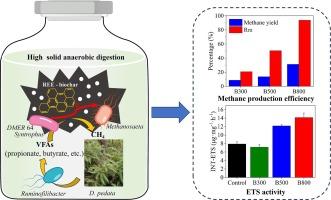解密富含稀土元素的生物炭在厌氧消化蝶形花生物质过程中的作用和机制
IF 6.7
1区 工程技术
Q2 ENERGY & FUELS
引用次数: 0
摘要
高固体厌氧消化(HSAD)是一种管理稀土尾矿区植物修复过程中产生的蝶形花生物质(DPB)的有前途的技术。富含稀土元素(REE)的DPB可通过直接热解的方法转化为生物炭,但REE-生物炭在HSAD工艺中的功效仍不明确。在此,我们在 300、500 和 800 °C 下生产了三种 REE 生物炭(B300、B500 和 B800)。结果表明,提高热解温度可改善 REE 生物炭的特性,如比表面积(SSA)、导电率(EC)、REE 含量和石墨化程度,但会降低其电子交换容量(EEC)。与 B300 和 B500 相比,添加 B800 明显提高了甲烷产量(分别高达 60% 和 29%)和最大甲烷产生率(分别高达 21% 和 15%)。微生物分析表明,B800 不仅富集了产酸菌(如 Ruminofilibacter)和电活性微生物(如 DMER64 和 Syntrophus),还提高了微生物代谢和电子传递能力。进一步的分析表明,B800 可通过法定人数感应系统协调关键菌属之间的相互作用,并通过其固有的石墨基质和 REE 氧化物调节电子传递,从而促进甲烷生成。这项研究为回收富含 REE 的生物质提供了一种新方法,并为设计功能性生物炭材料以提高 HSAD 性能提供了指导。本文章由计算机程序翻译,如有差异,请以英文原文为准。

Deciphering the role and mechanism of rare earth element-rich biochar during anaerobic digestion of Dicranopteris pedata biomass
High solid anaerobic digestion (HSAD) is a promising technology to manage Dicranopteris pedata biomass (DPB) that generated from the phytoremediation process of rare earth tailings area. Rare earth element (REE)-rich DPB can be converted to biochar via a direct pyrolysis approach, yet the efficacy of REE-biochar in the HSAD process remains unclear. Here, three types of REE-biochars (B300, B500 and B800) were produced at 300, 500 and 800 °C. The results showed that elevating pyrolysis temperature improved the REE-biochar properties such as specific surface area (SSA), electrical conductivity (EC), REE content, and graphitization degree, but reduced its electron exchange capacity (EEC). Compared to B300 and B500, the B800 addition clearly boosted methane yield (up to 60% and 29%) and maximum methane production rate (up to 21% and 15%). Microbial analysis showed that B800 not only enriched the acidogenic bacteria (e.g., Ruminofilibacter) and electroactive microbes (e.g., DMER64 and Syntrophus) but also enhanced microbial metabolisms and electron transfer ability. Further analysis showed that B800 facilitated methanogenesis probably by coordinating the interaction of key genera through quorum sensing system and modulating electron transfer through its intrinsic graphitic matrices and REE oxides. This study offered a new approach to recycling REE-rich biomass and a guidance to design functional biochar material for improving the HSAD performance.
求助全文
通过发布文献求助,成功后即可免费获取论文全文。
去求助
来源期刊

Fuel
工程技术-工程:化工
CiteScore
12.80
自引率
20.30%
发文量
3506
审稿时长
64 days
期刊介绍:
The exploration of energy sources remains a critical matter of study. For the past nine decades, fuel has consistently held the forefront in primary research efforts within the field of energy science. This area of investigation encompasses a wide range of subjects, with a particular emphasis on emerging concerns like environmental factors and pollution.
 求助内容:
求助内容: 应助结果提醒方式:
应助结果提醒方式:


